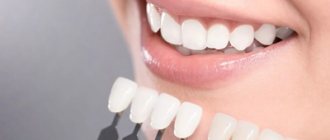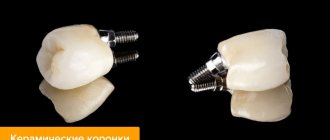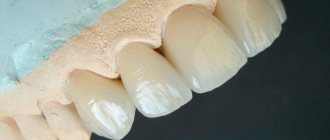Features of metal-ceramic crowns
The advantage of a metal-ceramic crown is that the frame is made from precious noble and non-precious alloys. The result is a super-strong base that rarely breaks. Structures made from natural materials are not attacked by microbes. Such crowns are excellent for hygienic types of prosthetics. There is no risk of damage to tissues or adjacent teeth; the material is not stained by food products. The service life of a metal-ceramic crown depends on proper care, correct installation, and the type of frame. If the base is made of gold, the design will retain its characteristics for up to 12-15 years.
Why troubles happen and what to do
Causes of problems with crowns:
- Wear
. The old crown has expired and is time to replace it. - Exceeding the permitted load
. Especially relevant for ceramics or porcelain coatings. - The material may crack due to temperature changes
. For example, after eating ice cream, the patient washes it down with hot tea. Such actions are also harmful to natural teeth. - The tooth under the crown is broken or rotting
. The denture has nothing to hold onto; it falls out with the remaining part of the tooth. - Errors of a technician
or doctor. This may be a violation of manufacturing technology or incorrect processing of the tooth.
If the crown breaks or falls out, in the period before visiting the dentist, reduce the load on this part of the dentition as much as possible. Only a doctor will be able to assess the condition of the tissues and root of the tooth, so you should not try to put on a fallen denture yourself if it seems that everything is fine with the tooth.
Advantages and disadvantages of metal-ceramic crowns
The main difference between a zirconium crown and a metal-ceramic crown is the risk of an allergic reaction to alloys made of nickel, chromium-nickel, gold, and other components. The metal oxidizes over time under the influence of saliva, and there is a possibility that a dark border will appear at the base of the prosthesis.
Advantages:
- Versatility - prosthetics of anterior teeth, high-quality restoration of chewing teeth.
- Aesthetics - the difference between metal-ceramic crowns and real teeth is difficult to determine visually, since the shade of the veneer is carefully selected.
- Maintainability - small chips, defects can be eliminated without removing the prosthesis.
- The fit is strong, there is no risk of developing caries due to the penetration of bacteria under the structure, but the fit is inferior in accuracy to zirconium, since the metal is cast and the zirconium crown is milled.
- Increased strength.
- High biocompatibility.
The disadvantages of metal-ceramic crowns include the need for significant grinding of teeth before installation. Prosthetics are not recommended if the teeth are severely damaged.
What to choose?
When installing crowns
When choosing a material for crowns, you must be guided by the following criteria:
- Despite its excellent aesthetic qualities, zirconium loses in strength, while a competing product has a more affordable pricing policy
reliability of the design;
- strength;
- durability;
- safety of installation and wearing;
- hypoallergenic;
- affordable price.
When analyzing metal ceramics and zirconium dioxide, a certain duality is observed.
Despite its excellent aesthetic qualities, zirconium loses in strength, while a competing product has a more affordable price policy.
An important factor is the degree of safety of the installation; in the case of a zirconium prosthesis, the tooth is subject to minimal grinding, and metal ceramics require depulpation.
Based on the information presented, the conclusion suggests itself that metal-ceramic products are more suitable for prosthetics of teeth performing the chewing function, and zirconium crowns are more suitable for the anterior teeth.
Before choosing any material, it is reasonable for the patient to consult a doctor. A specialist will help you understand this issue and advise which crown is best to install, taking into account the condition of the tooth’s bone tissue, dentin and other factors.
Metal-ceramic crowns - the disadvantage is the appearance of a black border along the gingival edge
Upon implantation
Zirconium dioxide is more suitable for prosthetics of anterior teeth
Despite the wide range of materials suitable for the manufacture of prostheses, only two types are most suitable for implantation: metal-ceramic and zirconium.
When using other options, different difficulties arise.
For example, chips and cracks appear on ceramic products, plastic tends to change tone and absorb odors, metal is generally not suitable in combination with pins.
Taking into account the advantages and features of metal ceramics and zirconium dioxide, we can summarize that the second option is more suitable for prosthetics of anterior teeth.
This is due to the light transmittance of the material, which allows you to skillfully imitate natural teeth.
If a metal-ceramic product is installed, there may be a problem with the lumen of the frame and the formation of cyanosis of the gums at the junction of the crown with the soft tissue.
Both options are ideal for prosthetics of chewing teeth. Therefore, when choosing a material for an implant, the patient should be guided by the budget and individual preferences.
Features of zirconium crowns
Zirconium dioxide crowns are a modern alternative to their analogues; they have no disadvantages or contraindications for the patient. The design is made of heavy-duty material and is 100% biocompatible, does not react with aggressive environments, and is not attacked by microbes. The main thing is the absence of a metal frame, which provokes allergies, oxidation, and the appearance of a dark stripe near the gums.
A prosthesis based on zirconium dioxide is distinguished by aesthetics, lasts 25-30 years, and does not darken. The method of its manufacture eliminates the risk of chipping, since the element is machined from a very hard monolithic block in a dental laboratory.
Zirconium crowns are made in different types:
- Monolithic - heavy-duty structures made from a whole block. Feature - the top layer is not covered with porcelain, the base and outer surface are the same. No risk of chipping.
- Classic - two-component design. The frame is made of zirconium dioxide, the top layer is porcelain lining.
The advantages of zirconium crowns over metal-ceramic ones are low-traumatic, safe prosthetics. Before installation, there is no heavy grinding of the enamel; there is no risk of injuring surrounding tissues.
How does the crown installation process work?
Metal-ceramic dental prosthetics is a long process that takes several stages. First, the patient will have to cure caries and other diseases of the oral cavity, then the enamel will be ground down and the nerve will be removed (if necessary). After this, an impression is made of the prepared tooth, which will be sent to a dental laboratory to make a crown (this can take up to 2 weeks). Then the fitting and adjustment of the structure is carried out.
The process of installing zirconium crowns is as follows:
- The patient undergoes an initial examination of the oral cavity by an orthodontist; if inflammatory processes are detected, further treatment will be required.
- The doctor grinds the tooth for the future crown and makes silicone impressions.
- The impressions are sent to the dental laboratory. The crown is modeled on a computer and then manufactured using high-precision milling equipment. The finished prosthesis is fired and painted.
- The crown is installed in the oral cavity using cement mortar. The procedure takes from 30 minutes to 3 hours.
Disadvantages of zirconium crowns
Disadvantages of durable structures
- Installation restrictions - it is not recommended to install dentures in the anterior region due to the low transparency of the base and limited choice of shades. But if the prostheses are made using Prettau technology, there are no restrictions due to the good aesthetics and natural color of the structures.
- Chips - this disadvantage is mitigated when choosing monolithic analogues.
- High price.
Orthopedic structures should be installed by an experienced doctor, which will reduce the risks of negative consequences for the patient.
Caring for tooth crowns
When studying the topic of dental crowns and trying to understand which ones are better, many rely on reviews from other patients and specialists. At the same time, any qualified doctor will tell you that to extend the life of a prosthetic device, you first need to pay attention to the rules of care.
For example, if you have a single crown installed, it is enough to carry out regular hygiene procedures using toothpaste, brush and dental floss. In the presence of bridge structures, as well as in patients with periodontal pockets in the area of dentures, it is necessary to resort to the help of irrigators. These devices help clean hard-to-reach areas from dental plaque and food debris.
Article expert (author):
Benefits of zirconium crowns
Prostheses are lightweight and compete in strength with their metal counterparts. The patient quickly gets used to the design, which has low thermal conductivity. Does not feel discomfort when eating cold or hot foods.
Advantages:
- Biocompatibility - the inert material will not cause inflammation, gum irritation, allergies, or damage to soft tissues.
- Preservation of primary characteristics - color, structure, density, integrity do not change during operation. The material is not colored with food dyes.
- Strength - the metal-free frame is not afraid of cracks, does not bend, and the risk of chipping is minimized.
- Resistant to chewing loads - you can eat hard foods.
- Durability - at least 15 years, in practice with proper care - 25-30.
- Aesthetics - the structure of the translucent material resembles a real tooth. You can create an exact copy that cannot be distinguished from the natural series by color and density.
- Hypoallergenic - does not provoke allergies, is harmless to the body, there are no contraindications.
- Comfort - due to their low weight, perfect fit, dentures do not interfere or create pressure on the gums.
Comparative characteristics of metal ceramics and zirconium
You can select the main parameters and use them to compare the main materials from which prostheses can be made:
- both materials are highly biocompatible and hypoallergenic;
- during the installation of such structures in the mouth, a person does not feel an unpleasant taste;
- both materials do not have any negative effect on the oral mucosa;
- in terms of manufacturing accuracy and aesthetics, zirconium crowns win;
- both types of prostheses are able to protect the tooth from secondary caries, but zirconium is able to cope with this much better;
- ceramic crowns last about 10 years, and zirconium models much longer (about 20 years);
- zirconium crowns will be almost 2 times more expensive than ceramic ones.
It's up to you to decide what material to make the crowns from. But you should initially consult and consult with a specialist. You will be able to understand whether you can have a certain type of prosthesis, whether there are any contraindications, and whether they will be effective
The main differences between a zirconium crown and a metal-ceramic crown
Difference between zirconium and metal-ceramic crowns:
| Indicators | Zirconium | Metal-ceramic |
| Strength of the finished structure | Increased | High |
| Bioinertness | 100% | There is a risk of metal oxidation under the influence of saliva. |
| Hypoallergenic | Allergic reactions to frame alloy components are possible. | |
| Lifetime | 25-30 years | 10-12 years |
| Aesthetics | Tall, teeth visually indistinguishable from your own | Low, there is a risk of a dark border appearing in the area |
| Production time | Fast | Long |
| Grinding of teeth before prosthetics | Minimal, no need to depulpate a living tooth | Significant, sometimes the tooth being restored is depulped |
| Light transmittance | High | Do not possess |
| Precision manufacturing | Jewelry - using CAD/CAM computer technology. No risk of gaps | The casting is done by a technician; the human factor may influence the accuracy. |
| Price | High | Low |
The Axioma Dental clinic invites patients for prosthetics and correction of complex dental defects. Highly qualified doctors, modern equipment - you are guaranteed an excellent smile.
Sources:
- Stepanov Alexander Gennadievich. Innovative concept of tooth-preserving medical technologies, 2018
- Fadeev A. Yu. Laboratory and experimental substantiation of the possibility of using zirconium fixed dentures. Abstract. dis. for the job application scientist step. Ph.D. Specialist. 14.00.21, 2002
- Maksimov G.V. Optimization of orthopedic treatment with metal-ceramic crowns on non-cast gold frames, 2004
Expert author:
Amiridi Marina Vladimirovna
Orthopedic dentist
The information presented in this article is provided for reference purposes and does not replace the advice of a qualified specialist.
At the first signs of illness, you should consult a doctor.
Tell us about us:
An alternative to crowns for chewing teeth
It should be remembered that even in the presence of significant damage, a tooth can be restored using a conventional light-composite filling and pin. If it is necessary to eliminate a single defect, implant fixation is recommended.
Which is preferable: a filling, a pin or a crown?
As mentioned earlier, with significant destruction of the coronal part of the tooth (more than 50%), it is possible to recreate it using a light-composite filling mass. In this case, a pin made of fiberglass or metal material is used, which allows for more reliable fixation of such a filling.
If the tooth crown is destroyed by more than 50%, experts recommend resorting to the use of a prosthesis. This primarily applies to units from which the pulp has been removed, as these are considered the most fragile.
Also, in case of significant destruction of the coronal part, dentists use a special stump insert, which ensures a more durable installation of the prosthesis.
What to choose: a crown or a dental implant?
When considering the replacement of missing units with crowns, implant fixation is the preferred option for eliminating a single defect. When using a dental structure, the need to prepare teeth that act as supporting elements is eliminated. In addition, implants have a longer period of use, in contrast to single prosthetic structures and bridges.










